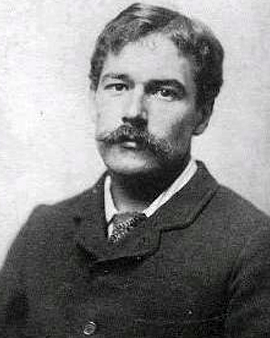Henry Scott Tuke was an English painter and photographer. He was born into a prominent family of social activists. His father Daniel was a prominent doctor and psychiatrist and one of the first to advocate the humane treatment of the mentally ill.
Tuke was a very prolific artist; more than 1,300 works by him are known. He became probably best known for his depictions of naked boys and young men, but he was also involved in marine painting and painted several well-known ship portraits.
In 1875 Tuke enrolled at the Slade School Of Art in London, where he studied with Alphonse Legros and Edward Poynter among others. A scholarship enabled him to continue his studies at Slade and in Italy until 1880. In Italy he painted his first pictures of naked young men, but these were not yet a central theme of his painting. In 1881 he moved to Paris. There he became friends with the American painter John Singer Sargent, but also with the Frenchman Jules Bastien-Lepage, who encouraged him to work not only in the studio but increasingly outdoors. Tuke decided to return to England, where some former friends and comrades had founded an artists' colony called the Newlyn School. It was in Newlyn that his first pictures of naked boys in boats were created. He remained there until 1885 when he moved back to Falmouth where he had grown up. Falmouth had a pleasant climate for the nude bathing that Tuke loved. Many of his most famous paintings were painted there. Tuke bought a boat and converted it into a floating studio. In the 1890s, Tuke gave up trying to put his nudes in a mythological setting, he now began to paint nude teenagers in everyday scenes of swimming and fishing. Tuke became a respected and wealthy painter and was even elected to the Royal Academy in 1914. At the age of 70, Tuke suffered a heart attack and died a year later, in 1929. In his will, he bequeathed generous sums of money to the men he had painted as children and teenagers. Many of these models are known by name, almost all of them were drafted at the beginning of the First World War, and some never returned.
After his death Tuke fell into oblivion. Only in the seventies he was rediscovered by a first generation of openly gay artists and art collectors.
×





.jpg)
.jpg)
.jpg)
.jpg)
.jpg)
.jpg)
.jpg)
.jpg)
.jpg)
.jpg)
.jpg)
.jpg)
.jpg)
.jpg)
.jpg)
.jpg)
.jpg)
.jpg)
.jpg)
.jpg)
.jpg)
.jpg)
.jpg)
.jpg)
.jpg)
.jpg)
.jpg)
.jpg)
.jpg)
.jpg)
.jpg)
.jpg)
_-_(MeisterDrucke-1209825).jpg)
_-_(MeisterDrucke-1209825).jpg)
.jpg)
.jpg)
.jpg)
.jpg)
.jpg)
.jpg)
.jpg)
.jpg)
.jpg)
.jpg)
.jpg)
.jpg)
.jpg)
.jpg)
.jpg)
.jpg)
.jpg)
.jpg)
.jpg)
.jpg)
.jpg)
.jpg)
 - (MeisterDrucke-279011).jpg)
 - (MeisterDrucke-279011).jpg)
.jpg)
.jpg)
.jpg)
.jpg)
.jpg)
.jpg)
.jpg)
.jpg)
.jpg)
.jpg)
.jpg)
.jpg)
 - (MeisterDrucke-163529).jpg)
 - (MeisterDrucke-163529).jpg)
.jpg)
.jpg)
.jpg)
.jpg)
.jpg)
.jpg)
.jpg)
.jpg)
.jpg)
.jpg)
 c1921 - (MeisterDrucke-222115).jpg)
 c1921 - (MeisterDrucke-222115).jpg)
.jpg)
.jpg)
.jpg)
.jpg)
.jpg)
.jpg)
.jpg)
.jpg)
.jpg)
.jpg)
.jpg)
.jpg)
.jpg)
.jpg)
.jpg)
.jpg)
.jpg)
.jpg)
.jpg)
.jpg)
 1908 - (MeisterDrucke-228473).jpg)
 1908 - (MeisterDrucke-228473).jpg)
.jpg)
.jpg)
.jpg)
.jpg)
.jpg)
.jpg)
.jpg)
.jpg)
.jpg)
.jpg)
.jpg)
.jpg)
.jpg)
.jpg)
.jpg)
.jpg)
.jpg)
.jpg)
.jpg)
.jpg)
.jpg)
.jpg)
.jpg)
.jpg)
.jpg)
.jpg)
.jpg)
.jpg)
.jpg)
.jpg)
.jpg)
.jpg)
.jpg)
.jpg)
.jpg)
.jpg)
_-_(MeisterDrucke-578029).jpg)
_-_(MeisterDrucke-578029).jpg)
.jpg)
.jpg)
.jpg)
.jpg)
.jpg)
.jpg)
.jpg)
.jpg)
.jpg)
.jpg)
.jpg)
.jpg)
_-_(MeisterDrucke-550520).jpg)
_-_(MeisterDrucke-550520).jpg)
_-_(MeisterDrucke-963479).jpg)
_-_(MeisterDrucke-963479).jpg)
.jpg)
.jpg)
 - (MeisterDrucke-638245).jpg)
 - (MeisterDrucke-638245).jpg)
.jpg)
.jpg)
.jpg)
.jpg)
.jpg)
.jpg)
 - (MeisterDrucke-638246).jpg)
 - (MeisterDrucke-638246).jpg)
.jpg)
.jpg)
_-_(MeisterDrucke-206550).jpg)
_-_(MeisterDrucke-206550).jpg)
.jpg)
.jpg)
.jpg)
.jpg)
.jpg)
.jpg)
.jpg)
.jpg)
.jpg)
.jpg)
.jpg)
.jpg)
.jpg)
.jpg)
.jpg)
.jpg)
.jpg)
.jpg)
.jpg)
.jpg)
.jpg)
.jpg)
.jpg)
.jpg)






